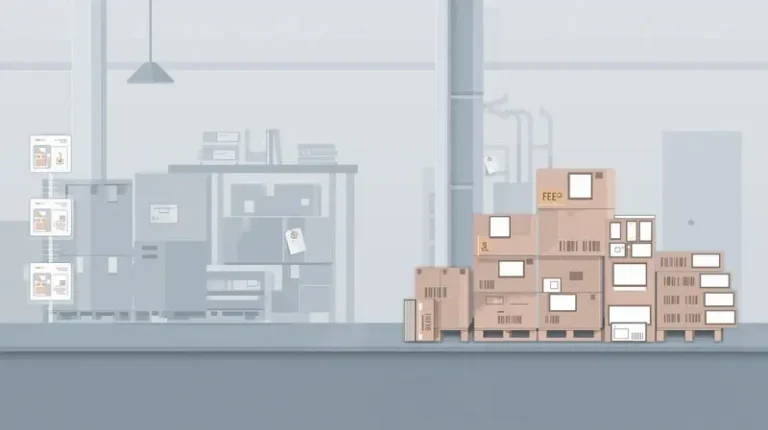Walmart Fulfillment Services (WFS): Benefits and Disadvantages

Last updated on July 15, 2025

In this article
 8 minutes
8 minutes
- What is Walmart Fulfillment Services (WFS)?
- Benefits of WFS: What Makes It Worth It
- WFS Storage and Handling
- WFS Security and Reliability
- WFS Scalability and Flexibility
- Disadvantages of WFS: Watch Out for These Drawbacks
- WFS Best Practices and Tips
- WFS vs. Amazon FBA: How Does It Stack Up?
- Should You Use Walmart Fulfillment Services?
- How Cahoot Can Help
- Frequently Asked Questions
Walmart Fulfillment Services (WFS) might be one of the best-kept secrets in ecommerce logistics. But is it the right fit for your business? That depends on a few things. Cost. Control. And whether you’re okay putting more of your operations in Walmart’s hands. Let’s dig into the pros and cons so you can make an informed decision, and maybe avoid some expensive missteps.
What is Walmart Fulfillment Services (WFS)?
WFS is Walmart’s in-house fulfillment service, designed to rival Amazon FBA. Sellers send inventory to Walmart fulfillment centers, and Walmart handles storage, picking, packing, shipping, and customer service. Eligible products gain the coveted “Fulfilled by Walmart” badge, and a marketplace seller can leverage Walmart’s massive supply chain infrastructure to deliver fast, low-cost shipping across the U.S.
Slash Your Fulfillment Costs by Up to 30%
Cut shipping expenses by 30% and boost profit with Cahoot's AI-optimized fulfillment services and modern tech —no overheads and no humans required!
I'm Interested in Saving Time and MoneyBenefits of WFS: What Makes It Worth It
1. Fast, Affordable Shipping
Walmart has one of the world’s largest supply chains, and when you plug into WFS, you benefit from that scale, including access to multiple fulfillment centers that enable fast shipping. Orders are delivered quickly (often 2-day shipping), as WFS provides fast shipping to meet rising customer expectations and boost conversion rates. WFS handles shipping orders efficiently through its extensive fulfillment network.
2. Walmart-Branded Packaging
Just like Amazon FBA, WFS uses branded packaging, which reinforces customer trust. It signals that the order is coming from Walmart directly, helping smaller brands piggyback off Walmart’s reputation.
3. Higher Product Visibility
WFS items often get better placement in search results, more Buy Box wins, and that prime real estate on Walmart listings. Walmart tags like “TwoDay,” “Free & Easy Returns,” and “Fulfilled by Walmart” help increase product visibility and build customer trust. If you’re already selling on the Walmart Marketplace, enrolling in WFS can give your listings a serious edge.
4. Seamless Integration with Seller Center
Managing WFS inventory and applying for Walmart Fulfillment Services (WFS) are handled directly through Walmart’s Seller Center. Sellers create and submit an inbound order to send inventory to Walmart’s fulfillment centers, ensuring products are available on Walmart.com without a steep learning curve.
5. Excellent Customer Service Coverage
Walmart handles returns, refunds, and order inquiries directly with customers, allowing sellers to focus on their core business. That’s a major lift off your plate, especially during peak season or rapid scaling.
WFS Storage and Handling
Walmart Fulfillment Services (WFS) offers sellers a robust storage and handling solution designed to keep your inventory safe, organized, and ready to ship. With a network of advanced fulfillment centers, WFS uses cutting-edge technology to automate sorting, packing, and storage processes, ensuring your products are always handled efficiently. Whether you need pallet, shelf, or floor storage, WFS can accommodate a wide range of product types and sizes, making it a versatile choice for any ecommerce business.
Through the Seller Center, you can easily monitor your inventory levels and track storage costs in real time. This transparency empowers sellers to make informed decisions about restocking, inventory turnover, and overall business strategy. By leveraging Walmart Fulfillment Services, you can focus on growing your business while knowing your products are stored securely and managed with care. The combination of advanced technology and flexible storage options makes WFS a smart choice for sellers looking to streamline their fulfillment operations and control costs.
Looking for a New 3PL? Start with this Free RFP Template
Cut weeks off your selection process. Avoid pitfalls. Get the only 3PL RFP checklist built for ecommerce brands, absolutely free.
Get My Free 3PL RFPWFS Security and Reliability
Security and reliability are at the core of WFS. Each Walmart fulfillment center is equipped with 24/7 surveillance, secure access controls, and alarm systems to protect your inventory from loss, damage, or theft. WFS’s fulfillment network is built on strict quality control protocols, ensuring that every item is handled and shipped with precision.
Sellers benefit from real-time inventory tracking and monitoring, so you always know where your products are within the fulfillment network. This level of transparency and oversight means you can trust Walmart Fulfillment Services to deliver your products to customers quickly and accurately. With WFS, sellers gain peace of mind knowing their inventory is safeguarded and their fulfillment process is in expert hands.
WFS Scalability and Flexibility
Walmart Fulfillment Services is designed to grow with your business, offering the scalability and flexibility needed to meet changing demands. Whether you’re ramping up for peak season, launching new products, or experiencing rapid sales growth, WFS’s fulfillment network can adapt to your evolving business needs. Sellers can easily adjust inventory levels, storage options, and shipping preferences through the platform, ensuring you’re always prepared for fluctuations in demand.
WFS also provides a variety of fulfillment solutions, including expedited shipping, so you can meet your customers’ expectations for fast delivery. This flexibility allows businesses to stay agile and responsive, no matter how the market shifts. By relying on Walmart Fulfillment Services, sellers can focus on increasing sales and expanding their ecommerce business, confident that their fulfillment partner can keep up every step of the way.
Disadvantages of WFS: Watch Out for These Drawbacks
1. Limited to Walmart Marketplace
With WFS, your inventory is stored in a single location, which can be a limitation for ecommerce businesses selling on multiple platforms. WFS only fulfills Walmart orders, so you can’t use it to fulfill Amazon, Shopify, or DTC ecommerce orders. This means maintaining parallel operations or using a separate 3PL for other ecommerce channels.
2. Additional and Hidden Fees
WFS fees include a fulfillment fee (based on size/weight), storage fees, and a monthly storage fee based on the volume of product and storage duration. But there are also additional fulfillment fees and additional fees for certain product categories, such as apparel, hazardous materials, and oversize items, as well as charges for long-term storage, prep services, and more. The costs can sneak up, especially if your inventory turnover isn’t fast.
3. No Support for Certain Product Types
Hazardous materials, hazmat items, perishable goods, and products over 150 lbs are not eligible for WFS. That limits WFS’s usefulness for some sellers.
4. Longer Inbound Processing Times
Compared to Amazon FBA, some sellers report slower receiving times and less transparency when it comes to tracking inbound shipments or resolving fulfillment center errors.
5. Control and Branding Limitations
You lose some control over the unboxing experience. It’s Walmart’s packaging and rules, not yours. If brand identity matters to you, that could be a deal-breaker.
Scale Faster with the World’s First Peer-to-Peer Fulfillment Network
Tap into a nationwide network of high-performance partner warehouses — expand capacity, cut shipping costs, and reach customers 1–2 days faster.
Explore Fulfillment NetworkWFS Best Practices and Tips
To maximize the benefits of Walmart Fulfillment Services (WFS), sellers should adopt a few key best practices. Start by keeping your inventory data accurate and up to date in the Seller Center to avoid costly stockouts or overstocking. Optimize your product listings and packaging to minimize shipping costs and speed up delivery times, which can boost customer satisfaction and repeat business.
Take advantage of WFS’s prep services to ensure your products are ready for fast, efficient shipping, and use Walmart’s branded packaging to reinforce trust with your customers. Regularly review your fulfillment costs and look for opportunities to streamline your operations. Walmart Fulfillment Services also provides a wealth of resources, like guides, webinars, and dedicated support, to help sellers continuously improve their fulfillment process. By following these tips, you can reduce costs, improve delivery performance, and create a better experience for your customers.
WFS vs. Amazon FBA: How Does It Stack Up?
The WFS program is Walmart’s distinct fulfillment offering, separate from Amazon FBA. Walmart Fulfillment Services pricing features a transparent fee structure, with fulfillment fees based on weight and storage fees based on volume and duration. Walmart also charges a referral fee on each sale, which differs from Amazon’s subscription model. But if multichannel fulfillment or international reach is important, FBA (or an alternative like Cahoot) might be a better fit.
Should You Use Walmart Fulfillment Services?
If you’re serious about selling on the Walmart Marketplace and your catalog qualifies, WFS can absolutely increase product visibility and improve fulfillment speed. WFS helps sellers fulfill orders efficiently by allowing them to store their inventory in Walmart’s network of distribution centers. Inventory storage is a key feature of WFS, enabling streamlined order processing and faster delivery. But it’s not a one-size-fits-all solution. It works best when you:
- Focus heavily on Walmart as a sales channel
- Want to simplify Walmart order fulfillment
- Are you okay with Walmart branding on packages?
If you’re selling on multiple platforms or you want more control and better economics across the board, it might make more sense to use a third-party fulfillment partner.
How Cahoot Can Help
Cahoot gives sellers the best of both worlds. You can fulfill Walmart orders (alongside Amazon, Shopify, and more) through a single platform. With Cahoot’s nationwide network, you get ultra-fast delivery, competitive storage rates, and control over packaging and branding, without needing to go all-in on a single marketplace. And yes, we integrate with WFS too, so you can optimize across channels.
Frequently Asked Questions
What is Walmart Fulfillment Services (WFS)?
WFS is Walmart’s in-house program that stores, picks, packs, and ships items for Marketplace sellers.
How much does WFS cost?
Fees include fulfillment and monthly storage, plus charges for returns, oversized items, and more.
Can WFS fulfill Amazon or Shopify orders?
No, WFS only works for Walmart Marketplace orders.
What products are not allowed in WFS?
Hazmat, perishables, items over 150 lbs, and some fragile goods are excluded.
Is WFS better than Amazon FBA?
It depends. WFS can offer better fees or support, but FBA supports more channels and SKUs.

Turn Returns Into New Revenue





